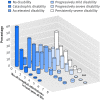The role of intervening hospital admissions on trajectories of disability in the last year of life: prospective cohort study of older people
- PMID: 25995357
- PMCID: PMC4443433
- DOI: 10.1136/bmj.h2361
The role of intervening hospital admissions on trajectories of disability in the last year of life: prospective cohort study of older people
Abstract
Objective: To evaluate the role of intervening hospital admissions on trajectories of disability in the last year of life.
Design: Prospective cohort study.
Setting: Greater New Haven, Connecticut, United States, from March 1998 to June 2013.
Participants: 552 decedents from a cohort of 754 community living people, aged 70 years or older, who were initially non-disabled in four essential activities of daily living: bathing, dressing, walking, and transferring.
Main outcome measure: Occurrence of admissions to hospital and severity of disability (range 0-4), ascertained during monthly interviews for more than 15 years.
Results: In the last year of life, six distinct trajectories of disability were identified, from least disabled to most disabled: 95 participants (17.2%) had no disability, 61 (11.1%) had catastrophic disability, 53 (9.6%) had accelerated disability, 61 (11.1%) had progressively mild disability, 127 (23.0%) had progressively severe disability, and 155 (28.1%) had persistently severe disability. 392 (71.0%) participants had at least one hospital admission and 248 (44.9%) had multiple hospital admissions. For each trajectory the course of disability closely tracked the monthly prevalence of hospital admission. In a set of multivariable models that included several potential confounders, hospital admission in a given month had a strong independent effect on the severity of disability, in both relative and absolute terms. The largest absolute effect was observed for catastrophic disability, with a mean increase in disability score of 1.9 (95% confidence interval 1.5 to 2.4) in the setting of a hospital admission, corresponding to a rate ratio (or relative effect) of 2.0 (95% confidence interval 1.5 to 2.7).
Conclusions: In the last year of life, acute hospital admissions play an important role in the disabling process. Knowledge about the course of disability before these intervening events may facilitate clinical decision making at the end of life. For older patients admitted to hospital with progressive or persistent levels of severe disability, representing more than half of the decedents, clinicians might consider a palliative care approach to facilitate discussions about advance care planning and to better deal with personal care needs.
© Gill et al 2015.
Conflict of interest statement
Competing interests: All authors have completed the ICMJE uniform disclosure form at
Figures



Comment in
-
Worsening disability in older people: a trigger for palliative care.BMJ. 2015 May 20;350:h2439. doi: 10.1136/bmj.h2439. BMJ. 2015. PMID: 25993988 No abstract available.
References
-
- Covinsky KE, Pierluissi E, Johnston CB. Hospitalization-associated disability: “She was probably able to ambulate, but I’m not sure.” JAMA 2011;306:1782-93. - PubMed
-
- Gill TM, Desai MM, Gahbauer EA, et al. Restricted activity among community-living older persons: incidence, precipitants, and health care utilization. Ann Intern Med 2001;135:313-21. - PubMed
Publication types
MeSH terms
Grants and funding
LinkOut - more resources
Full Text Sources
Other Literature Sources
Medical
